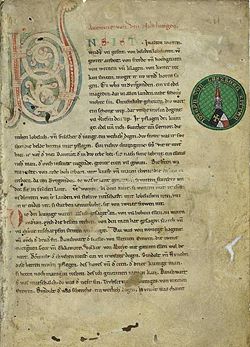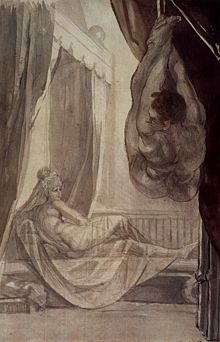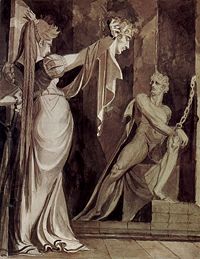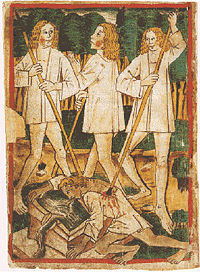Nibelungenlied
The Nibelungenlied, translated as The Song of the Nibelungs, is an epic poem in Middle High German. It tells the story of dragon-slayer Siegfried at the court of the Burgundians, his murder, and of his wife Kriemhild's revenge, which ultimately brings about the deaths of every one of the main protagonists.
The Nibelungenlied is based on pre-Christian Germanic heroic motifs (the Nibelungensaga), which include oral traditions and reports based on historic events and individuals of the fifth century and sixth centuries C.E. Old Norse parallels of the legend survive in the Völsunga saga, the Prose Edda, the Poetic Edda, the Norna-Gests þáttr (Legend of Norna-Gest), and the Þiðrekssaga. The Nibelungenlied is a wealth of information about pre-Christian German culture. These traditions are not revealed religions, based on a scripture, but an older form that comes to us from oral tradition. These traditions are based on the pre-Christian paganism that pervaded ancient European culture.
Manuscript sources
The poem in its various written forms was lost by the end of the sixteenth century, but was re-discovered during the eighteenth century. There are 35 known manuscripts of the Nibelungenlied and its variant versions. Eleven of these manuscripts are essentially complete, and 24 are in various fragmentary states of completion, including one version in Dutch (manuscript "T"). The text contains approximately 2,400 stanzas in 39 Aventiuren. The title under which the poem has been known since its discovery is derived from the final line of one of the three main versions, hie hât daz mære ein ende: daz ist der Nibelunge liet ("here the story takes an end: this is the lay of the Nibelungs"). Liet here means "lay," "tale," or "epic" rather than simply "song," as it would in Modern German.
The manuscripts' sources deviate considerably from one another. Philologists and literary scholars usually designate three main genealogical groups for the entire range of available manuscripts, with two primary versions comprising the oldest known copies: *AB and *C. This categorization derives from the signatures on the *A, *B, and *C manuscripts as well as the wording of the last verse in each source: daz ist der Nibelunge liet or daz ist der Nibelunge nôt. Nineteenth-century philologist Karl Lachmann developed this categorization of the manuscript sources in Der Nibelunge Noth und die Klage nach der ältesten Überlieferung mit Bezeichnung des Unechten und mit den Abweichungen der gemeinen Lesart.[1]
Authorship
Prevailing scholarly theories strongly suggest that the written Nibelungenlied is the work of an anonymous poet from the area of the Danube between Passau and Vienna, dating from about 1180 C.E. to 1210 C.E., possibly at the court of the bishop of Passau, Wolfger von Erla (1191–1204). Most scholars consider it likely that the author was a man of literary and ecclesiastical education at the bishop's court, and that the poem's recipients were the clerics and noblemen at the same court.
The "Nibelung's lament," a sort of appendix to the poem proper, mentions a "Meister Konrad" who was charged by a bishop "Pilgrim" of Passau with the copying of the text. This is taken as a reference to Saint Pilgrim, bishop of Passau from 971–991.
The search for the author of the Nibelungenlied in German studies has a long and intense history. Among the names suggested were Konrad von Fußesbrunnen, Bligger von Steinach and Walther von der Vogelweide. None of these hypotheses has wide acceptance, and mainstream scholarship today accepts that the author's name cannot be established.
Synopsis
Though the preface to the poem promises both joyous and dark tales ahead, the Nibelungenlied is by and large a very tragic work, and these four opening verses are believed to have been a late addition to the text, composed after the body of the poem had been completed.
| Middle High German original | Shumway translation |
|---|---|
|
Uns ist in alten mæren wunders vil geseit |
Full many a wonder is told us in stories old, |
.
The epic is divided into two parts, the first dealing with the story of Siegfried and Kriemhild, the wooing of Brünhild and the death of Siegfried at the hands of Hagen, and his hiding of the Nibelung treasure in the Rhine (Aventiures 1-19). The second part deals with Kriemhild's marriage to Etzel, her plans for revenge, the journey of the Nibelungs to the court of Etzel, and their last stand in Etzel's hall (Aventiures 20-39).
Siegfried and Kriemhild
Aventiure 1 introduces the court of Burgundy. Kriemhild, the virginal sister of King Gunther and his brothers Gernot and Giselher, has a dream of a falcon that is killed by two eagles. Her mother interprets this to mean that Kriemhild's future husband will die a violent death, and Kriemhild consequently resolves to remain unmarried.
Aventiure 2 tells of the background of Siegfried, crown prince of Xanten. He is already a warrior of great renown prior to the main events of the poem, most famous for slaying the dragon Fafnir and stealing its giant hoard of treasure, the Nibelungenschatz. After killing the dragon, he bathed in its blood, rendering him invulnerable. Unfortunately for Siegfried, a leaf fell from a linden tree above him while he was bathing and landed on his back, and the tiny patch of skin that it covered did not come into contact with the dragon's blood, so that Siegfried remained vulnerable in that one spot (paralleling the ancient Greek hero Achilles). In Aventiure 3, Siegfried arrives in Worms with the hopes of wooing Kriemhild, but her family refuses to allow him to even set eyes on her. Disappointed, he nonetheless remains in Worms and helps Gunther defeat the invading Saxons (4). Siegfried finally meets Kriemhild (5), and is allowed to marry her after he helps Gunther to defeat Brünhild, the queen of Iceland, with his heroic strength and the aid of a cloak which allows him to become invisible (6-8). On a visit to Iceland, Siegfried posed as a vassal of Gunther's, and Brünhild is deceived into believing that Siegfried is of low rank in order to conceal his plan to woo her.
On the wedding night, Brünhild's great strength and unwillingness are overcome once again by Gunther, but only with the aid of an invisible Siegfried, who takes her ring and belt (symbols of defloration) as presents for his wife, Kriemhild (10).
Years later, Siegfried and Kriemhild are on a visit to Worms. Brünhild is still under the impression that Gunther married off his sister to a low-ranking vassal, while Gunther and Siegfried are in reality of equal rank. Before entering the Worms Cathedral, Kriemhild and Brünhild argue who should have primacy, depending on the ranks of their husbands. To Brünhild it is obvious that she should have precedence. Kriemhild, unaware of the deception involved in Brünhild's wooing, insists that they are of equal rank, and as the dispute escalates, she shows Brünhild the belt which Siegfried had taken from her and calls her Siegfried's kebse (mistress or concubine).
The argument between the queens is both a risk for the marriage of Gunther and Brünhild as well as a possible cause for a rivalry between Gunther and Siegfried. Hagen von Tronje, the dark, cruel, and faithful vassal of Gunther, decides to kill Siegfried to protect the honor and reign of his king. Although it is Hagen who does the deed, Gunther and his brothers know of the plan and quietly assent. He persuades Kriemhild to mark Siegfried's vulnerable spot with a cross as a divine protection, which he uses as a target, killing him with a spear while Siegfried is drinking from a well during a hunt. Hagen also steals the hoard from Kriemhild, throwing it into the Rhine (Rheingold), to prevent Kriemhild from using it to establish an army of her own.
Kriemhild's revenge
Kriemhild swears to take revenge for the murder of her husband and the theft of her treasure. Many years later, King Etzel of the Huns (Attila the Hun) proposes to Kriemhild, and they get married. For the baptism of their son, she invites her brothers, the Burgundians, to a feast at Etzel's castle in Hungary. Hagen does not want to go, but is taunted until he does; he realizes that it is a trick of Kriemhild in order to take revenge and kill him, and his fellow Burgundians. This fate is confirmed by Nixes as they cross the Danube. He predicted that all but one monk would die. Hagen tries to drown the monk in order to render the prophecy futile, but he survives.
On their arrival at the feast, the Burgundians demand to keep their weapons, which is an offense, but accepted by Etzel. The tragedy unfolds. Kriemhild demands the return of her Nibelungenschatz, which has been stolen by Hagen, but he decapitates the son of Kriemhild and Etzel, starting an open fight. The Burgundians take control of the hall, which is besieged by Etzel's warriors. Kriemhild offers to let her brothers leave if they hand over Hagen, but the Burgundians refuse.
Eventually all of the Burgundians are killed except for Hagen and Gunther, who are bound and held prisoner by Dietrich. Kriemhild later comes to their jail cell and beheads first Gunther and then Hagen when he refuses to reveal the location of the treasure hoard. Hildebrand is infuriated by the shameful deaths of the men and hews Kriemhild to pieces with his sword. In a variant of Manuscript B, he is said to strike Kriemhild a single clean blow to the waist; she feels no pain, however, and declares that his sword is useless. Hildebrand then drops a ring and commands Kriemhild to pick it up. As she bends down, her body falls into pieces. Dietrich and Etzel and all the people of the court lament the deaths of the heroes.
Historical background
A possible archetype for the dragon-slayer Siegfried might have been the historical figure of Arminius, who defeated the Roman imperial legions (clad in scale armor) at the Battle of Teutoburg Forest in 9 C.E.
A historical nucleus of the saga lies in events of the Germanic Migration Period, in particular the defeat of the Burgundians by Flavius Aëtius with the aid of Hunnic mercenaries near Worms, Germany ca. 436 C.E. Other possible influences are the feud between the sixth-century Merowingian queens Brunichild and Fredegunde, as well as the marriage of Attila with the Burgundian princess Ildikó in 453 C.E.
These events became conflated with common Germanic mythological material concerning Niflheim and the Nibelungs, originally likely a race of dwarfs guarding treasure, but from the evidence of Waltharius also a name for a Frankish or Burgundian dynasty. The Nibelungenlied combines a first mythological part dealing with Gunther's wooing of Brünhild, with a second political part taking place in specific locations like Worms, the capital of Burgundy, describing the journey of the Nibelungs east across the Danube to Etzelburg, the residence of Attila the Hun (Etzel), the location of the catastrophe.
The author of Nibelungenlied arranges these traditional materials in a composition aiming at a High Medieval audience that was familiar with the epics "Matter of Britain" and "Matter of France," casting the inherited Germanic theme in his contemporary terms of courtly Christian chivalry. Consequently, Siegfried changes from a dragon killer to a courting man who will express his love to Kriemhild explicitly only after he has won the friendship of the Burgundian king Gunther and his brothers, Gernot and Giselher. Some situations, which exaggerate the conflict between the Germanic migrations and the chivalrous ethics (such as Gunther's embarrassing wedding night with Brünhild), may be interpreted as irony. The notoriously bloody end that leaves no hope for reconciliation is far removed from the happy ending of typical courtly epics.
Textual history
The epic was lost during the sixteenth century, and was rediscovered with the finding of a manuscript (C) in 1755 in Hohenems, Vorarlberg. About three dozen manuscripts survive, with three main manuscripts labelled by Karl Lachmann as A, B, and C:
- A: Hohenems-Munich codex, late thirteenth century, discovered in Hohenems, now kept in Munich
- B: St. Gallen codex, thirteenth century, kept in the St. Gallen Abbey library
- C: Hohenems-Laßberg / Donaueschingen codex (early thirteenth century), since 2001 kept in Karlsruhe
These three manuscripts preserve three variants of the text with an uncertain relationship. It is impossible to condense them into a single "original" version, likely because oral tradition had a continuing influence on manuscript tradition during the thirteenth century.
The text was edited by Karl Bartsch in 1870. A Modern German translation by Karl Simrock appeared in 1826 and an English translation by Daniel B. Shumway in 1909.
Legacy
An early critic labeled it a German Iliad, arguing that, like the Greek epic, it goes back to the remotest times and unites the monumental fragments of half-forgotten myths and historical personages into a poem that is essentially national in character.
The word Nibelungen is transferred from a legendary race of Germanic dwarfs and their treasure, to the followers of Siegfried, and finally to the Burgundians which are portrayed in the poem.
The faithfulness among the Burgundian king and his vassals, ranked higher than family bonds or life, is called Nibelungentreue. This expression was used in Germany prior to World War I to describe the alliance between the German Empire and Austria-Hungary, as well as in Nazi Propaganda, e.g., when referring to the Battle of Stalingrad.
Adaptations
The Nibelungenlied, Thidreks saga, and the Völsunga saga served as source materials for Richard Wagner's Der Ring des Nibelungen (English: The Ring of the Nibelungs), a series of four music dramas popularly known as the "Ring Cycle."
In 1924, Austrian-American director Fritz Lang made a duology of silent fantasy films of the epic: Die Nibelungen: Siegfried and Die Nibelungen: Kriemhilds Rache. Lang and Thea von Harbou wrote the screenplay for the first film; von Harbou has the sole screenwriting credit on the second. Remakes were made in 1966.
Editions
- Karl Bartsch, 1870/1880.
- Margaret Armour, Trans.; Franz Schoenberner, Intro.; Edy Legrand, Illustrator, The Nibelungenlied (New York: Heritage Press, 1961).
- Michael S. Batts, Das Nibelungenlied, critical edition (Tübingen: M. Niemeyer, 1971 ISBN 3-484-10149-0).
- Helmut de Boor, Das Nibelungenlied, 22nd revised and expanded edition, Roswitha Wisniewski, editor (Wiesbaden, 1988 ISBN 3-7653-0373-9).
- Hermann Reichert, Das Nibelungenlied, edition of manuscript B (Berlin: de Gruyter, 2005 ISBN 3-11-018423-0).
- Ursula Schulze, Das Nibelungenlied, based on manuscript C (Düsseldorf / Zürich: Artemis and Winkler, 2005).
Notes
- ↑ Berlin: Reimer, 1826.
ReferencesISBN links support NWE through referral fees
- Gentry, Francis G. and Walter, James K., eds. 1995. German epic poetry. Continuum. ISBN 0826407439
- Jefferis, Sibylle. 2006. The Nibelungenlied: Genesis, Interpretation, Reception (Kalamazoo papers 1997-2005). Kummerle.
- Merwin, W. S. 1998. Medieval Epics. Modern Library. ISBN 0679603018
External links
All links retrieved November 14, 2022.
- Facsimile of manuscript C.
- Karl Bartsch edition (Leipzig, 1870/80).
Credits
New World Encyclopedia writers and editors rewrote and completed the Wikipedia article in accordance with New World Encyclopedia standards. This article abides by terms of the Creative Commons CC-by-sa 3.0 License (CC-by-sa), which may be used and disseminated with proper attribution. Credit is due under the terms of this license that can reference both the New World Encyclopedia contributors and the selfless volunteer contributors of the Wikimedia Foundation. To cite this article click here for a list of acceptable citing formats.The history of earlier contributions by wikipedians is accessible to researchers here:
The history of this article since it was imported to New World Encyclopedia:
Note: Some restrictions may apply to use of individual images which are separately licensed.




